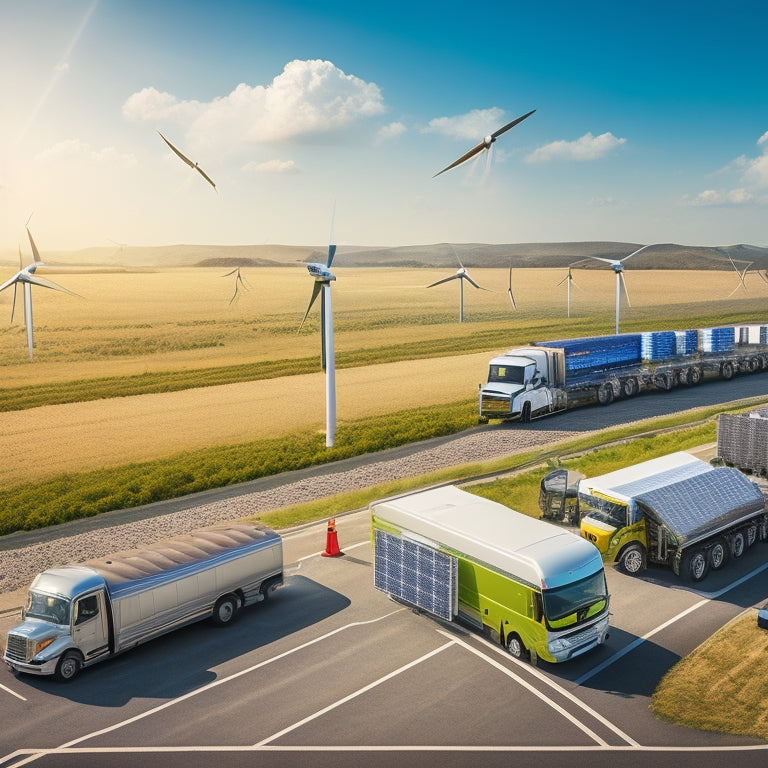
10 Best Renewable Energy Solutions for Fleet Owners
Share
You're looking to shift your fleet to renewable energy solutions, reducing your carbon footprint and operating costs. Consider these 10 top options: solar panels for fleet vehicles, electric vehicle charging stations, biodiesel fuel systems integration, wind turbines for fleet depots, hybrid electric fleet solutions, green hydrogen fuel cells, geothermal energy for fleets, biofuels for commercial vehicles, energy storage systems for fleets, and regenerative braking systems. Each offers unique benefits, from reduced emissions to cost savings. Explore these innovative solutions further to discover which ones best fit your fleet's specific needs and pave the way to a more sustainable future.
Key Takeaways
• Solar panels on fleet vehicles can reduce reliance on fossil fuels, power auxiliary systems, and decrease operating costs and carbon footprint.
• Electric vehicle charging stations, such as Level 2 and DC Fast Charging, can be customized to meet fleet needs and ensure vehicles are always ready to operate.
• Biodiesel fuel systems integration can reduce emissions and operating costs, and are eligible for incentives and tax breaks, making them a cost-effective option.
• Hybrid electric fleet solutions combine internal combustion engines with electric motors to greatly reduce emissions and operating costs, while improving fuel efficiency.
• Green hydrogen fuel cells can produce electricity with hydrogen and oxygen, offering improved fuel efficiency and durability, with lower maintenance costs due to fewer moving parts.
Solar Panels for Fleet Vehicles
As you explore ways to reduce your fleet's carbon footprint, consider integrating solar panels into your vehicles, which can provide a supplementary power source and extend their range. This innovative approach, known as solar integration, can greatly contribute to your fleet electrification efforts.
By harnessing the power of the sun, you can reduce your reliance on fossil fuels and lower your emissions. Solar panels can be installed on the roofs or hoods of your vehicles, generating electricity to power auxiliary systems, such as lights, radios, and refrigeration units. This not only reduces your carbon footprint but also decreases your operating costs.
Additionally, solar integration can increase the overall efficiency of your fleet, as vehicles can operate for longer periods without recharging. By adopting this technology, you can stay ahead of the curve in the shift to a more sustainable transportation sector.
With solar panels, you can take a significant step towards a cleaner, more environmentally friendly fleet.
Electric Vehicle Charging Stations
You'll need a reliable and efficient way to recharge your electric fleet vehicles, which is where strategically located electric vehicle charging stations come into play. As a fleet owner, it's important to invest in a well-designed charging infrastructure that meets your unique needs. This includes considering factors such as charging speed, station capacity, and networking capabilities.
| Charging Station Type | Charging Speed | Recommended Use Case |
|---|---|---|
| Level 2 (240V) | 4-8 hours | Depot charging for overnight recharging |
| DC Fast Charging | 30-60 minutes | High-traffic routes and long-haul trucks |
| High-Power Charging | 15-30 minutes | High-demand routes and heavy-duty applications |
| Opportunity Charging | 1-2 hours | Short breaks and lunch stops |
| Destination Charging | 2-4 hours | Long-term parking and overnight stays |
When designing your charging station, prioritize safety features such as emergency stop buttons, electrical surge protection, and weather-resistant enclosures. By investing in a well-planned charging infrastructure, you can make sure your electric fleet vehicles are always ready to roll.
Biodiesel Fuel Systems Integration
When integrating biodiesel fuel systems into your fleet, you'll need to assess the compatibility of your engines with biodiesel blends, as not all engines are suitable for use with biodiesel.
You'll also need to modify your fuel systems to accommodate biodiesel, which may involve upgrading fuel tanks, pumps, and filters.
Biodiesel Engine Compatibility
Your fleet's shift to biodiesel fuel systems integration relies heavily on confirming that your existing engines are compatible with biodiesel blends. This is vital to maintaining fuel efficiency and engine durability.
You'll want to verify that your engines can handle the unique properties of biodiesel, such as its higher viscosity and density compared to traditional diesel fuel. Incompatible engines may experience reduced performance, decreased fuel efficiency, and even premature wear and tear.
To guarantee a seamless shift, you'll need to assess your engines' compatibility with biodiesel blends. Check your engine manuals or consult with the manufacturer to determine the recommended biodiesel blend ratio. Some engines may require modifications or upgrades to accommodate biodiesel fuel systems integration.
Prioritizing engine durability and fuel efficiency is critical to maintaining your fleet's overall performance and reducing downtime. By doing so, you'll be able to reap the benefits of biodiesel fuel systems integration while minimizing potential risks.
Fuel System Modifications
As you prepare to integrate biodiesel fuel systems into your fleet, modifying your fuel systems to accommodate biodiesel's unique properties becomes a necessary step to guarantee peak performance and prevent potential issues. You'll need to take into account the fuel's higher viscosity and density, which can affect fuel efficiency and engine performance.
Modifying your fuel systems will make certain that your engines can handle the differences between biodiesel and traditional diesel fuel.
To achieve peak fuel efficiency, you may need to adjust your fuel injectors, fuel pumps, and fuel lines to accommodate biodiesel's unique properties. Additionally, you may need to customize your fuel system to optimize fuel flow and pressure.
This customization will ensure that your engines receive the right amount of fuel at the right pressure, resulting in improved fuel efficiency and reduced maintenance costs.
By modifying your fuel systems, you can guarantee a seamless integration of biodiesel and maximize the benefits of this renewable energy solution.
With the right modifications, you can enjoy improved fuel efficiency, reduced emissions, and lower operating costs.
Emission Reduction Benefits
By incorporating biodiesel fuel systems into your fleet, you can markedly reduce greenhouse gas emissions and improve air quality, ultimately contributing to a cleaner environment. This reduction in emissions not only benefits the environment but also benefits your business through various incentives.
You can take advantage of Clean Air Incentives, which provide financial rewards for reducing air pollution. Additionally, you may be eligible for Environmental Tax Breaks, further reducing your operational costs.
Wind Turbines for Fleet Depots
As you consider wind turbines for your fleet depot, you'll need to think strategically about turbine placement to maximize energy generation. By doing so, you can achieve depot energy independence and greatly reduce your carbon footprint.
Turbine Placement Strategies
Optimizing turbine placement at your fleet depot involves carefully selecting sites with consistent wind patterns, taking into account factors like wind direction, speed, and turbulence to maximize energy generation.
You'll want to identify areas with minimal turbulence, as this can reduce energy output and increase maintenance costs. Turbine optimization is vital, as it directly impacts the efficiency of your wind energy system.
Conducting a thorough wake analysis will help you determine the best spacing and orientation of your turbines to minimize interference and maximize energy production. By analyzing wind patterns and turbine placement, you can increase energy output, reduce costs, and ensure a safe and reliable operation.
Additionally, consider the layout of your depot, taking into account obstacles, access roads, and maintenance areas to guarantee easy turbine access and maintenance. By carefully planning your turbine placement, you can create a safe, efficient, and profitable wind energy system that meets your fleet's energy needs.
Depot Energy Independence
You can achieve depot energy independence by integrating wind turbines into your fleet's energy infrastructure. This reduces reliance on external power sources and mitigates the risks associated with price volatility.
This approach enables you to generate clean energy on-site, thereby reducing your fleet's carbon footprint and energy costs.
To guarantee a successful implementation, conduct an energy audit to identify areas of energy inefficiency and opportunities for improvement. This assessment will help you determine the best wind turbine size and placement for your depot.
Reduced Carbon Footprint
By integrating wind turbines into your fleet's energy infrastructure, how much of a carbon footprint reduction can you realistically expect to achieve? The answer lies in the numbers.
A single wind turbine can offset around 2,000 tons of CO2 emissions annually, equivalent to taking approximately 400 cars off the road.
For a fleet owner, this translates to a significant reduction in carbon emissions, contributing to a cleaner and more sustainable logistics operation.
Hybrid Electric Fleet Solutions
Hybrid electric fleet solutions seamlessly integrate conventional internal combustion engines with electric motors, greatly reducing emissions and operating costs for your fleet. By combining the two powertrains, you can enjoy improved fuel efficiency, which leads to cost savings. This setup allows your vehicles to optimize fuel consumption, reducing your fleet's carbon footprint. With hybrid electric solutions, you can expect to see a significant decrease in fuel costs, which can add up to substantial savings over time.
Moreover, hybrid electric fleets are designed with safety in mind. They're equipped with advanced safety features, such as regenerative braking, which captures kinetic energy and converts it into electrical energy, further improving fuel efficiency.
Additionally, hybrid electric vehicles are designed to reduce noise pollution, creating a quieter and safer driving experience for your drivers and passengers.
Green Hydrogen Fuel Cells
As fleet owners continue to seek innovative solutions to reduce emissions and operating costs, green hydrogen fuel cells emerge as a promising alternative, offering a zero-emission propulsion system that's gaining traction in the transportation sector. You're likely wondering how this technology works and what benefits it can bring to your fleet.
Green hydrogen fuel cells combine hydrogen with oxygen to produce electricity, with water and heat as the only byproducts. This clean energy source offers several advantages, including:
| Advantage | Description | Benefit |
|---|---|---|
| Improved Fuel Efficiency | Converts chemical energy into electricity with higher efficiency than traditional fossil fuels | Reduced fuel costs |
| Enhanced Durability | Hydrogen fuel cells have fewer moving parts, reducing wear and tear | Lower maintenance costs |
| Abundant Hydrogen Supply | Hydrogen can be produced from various sources, including renewable energy | Reduced dependence on fossil fuels |
Geothermal Energy for Fleets
While you're exploring alternative energy sources, geothermal energy emerges as a promising solution for fleets, leveraging heat from the Earth's subsurface to generate electricity and power your vehicles.
By harnessing the Earth's natural heat, you can reduce your reliance on fossil fuels and lower your carbon footprint. Geothermal energy is particularly suitable for fleets operating in regions with significant geothermal activity, as identified through heat maps.
These maps help pinpoint areas with high thermal energy potential, making it easier to identify ideal locations for geothermal energy harvesting. By deploying geothermal energy systems, you can establish a stable and reliable source of power for your fleet.
This renewable energy solution not only reduces emissions but also provides a safe and sustainable option for powering your vehicles. As you explore geothermal energy for your fleet, consider the long-term benefits of energy independence and reduced operating costs.
Biofuels for Commercial Vehicles
As you contemplate shifting your commercial fleet to renewable energy, biofuels are a viable option worth exploring.
You'll want to familiarize yourself with the different types of biofuels available, each with its own unique benefits and limitations.
Types of Biofuels
To guarantee, it's crucial to
You can choose from various types of biofuels, each with its own set of benefits and challenges, to power your commercial vehicles. When selecting a biofuel, consider the following options:
-
Biodiesel: Derived from vegetable oils or animal fats, biodiesel is a popular choice for diesel engines. It offers a cleaner-burning alternative to traditional diesel fuel.
-
Cellulosic ethanol: Produced from non-food biomass like agricultural waste, cellulosic ethanol is a low-carbon alternative to traditional fossil fuels.
-
Algal oil: Derived from algae, this biofuel offers a promising solution for reducing greenhouse gas emissions and dependence on fossil fuels.
When exploring these biofuel options, consider factors like fuel efficiency, emissions reduction, and infrastructure compatibility.
To make an informed decision about the best fit for your fleet's unique needs and operational requirements, it's crucial to weigh the pros and cons of each type.
Emissions Reduction
Moreover, by adopting biofuels for your commercial vehicles, you can greatly reduce greenhouse gas emissions and contribute to a cleaner environment. As a fleet owner, you have a significant role in reducing your carbon footprint, and biofuels can be an effective solution.
By switching to biofuels, you can lower your emissions by up to 80%, depending on the type of biofuel used. This reduction in emissions can also lead to cost savings through carbon pricing and green taxes. In many regions, governments offer incentives for fleets that adopt environmentally friendly practices, including the use of biofuels. By reducing your emissions, you can benefit from these incentives and reduce your operating costs.
Moreover, biofuels can help you comply with increasingly stringent emissions regulations, avoiding potential fines and penalties. By making the switch to biofuels, you can not only reduce your environmental impact but also improve your bottom line.
Fleet Compatibility
When integrating biofuels into your fleet, compatibility with your commercial vehicles is key, as not all vehicles are optimized to run on these alternative fuels. As a fleet owner, you need to confirm that your vehicles can handle biofuels without compromising performance or safety.
To guarantee a seamless shift, consider the following factors:
-
Vehicle engine compatibility: Check if your vehicles' engines are designed to run on biofuels, as some may require modifications or upgrades.
-
Fuel system compatibility: Verify that your vehicles' fuel systems, including fuel tanks, fuel lines, and fuel injectors, are compatible with biofuels.
-
Performance and efficiency: Assess how biofuels will impact your vehicles' performance, fuel efficiency, and overall fleet management.
Energy Storage Systems for Fleets
Fleet owners can greatly decrease their reliance on fossil fuels by incorporating energy storage systems into their operations, thereby tapping into the full potential of renewable energy solutions. Energy storage systems provide a reliable and efficient way to store excess energy generated from renewable sources, reducing the strain on the grid and minimizing downtime.
| Benefits | Description |
|---|---|
| Increased Grid Resiliency | Energy storage systems help maintain a stable grid by providing backup power during outages |
| Reduced Energy Costs | Stored energy can be used to offset peak demand and reduce energy costs |
| Improved Battery Maintenance | Regular cycling of energy storage systems helps maintain battery health and extends lifespan |
| Enhanced Safety | Energy storage systems can provide backup power during emergencies, ensuring safety and minimizing disruptions |
Regenerative Braking Systems
You can greatly reduce your fleet's energy consumption by harnessing the kinetic energy generated by your vehicles' braking systems through regenerative braking technology. This innovative solution captures the kinetic energy that's typically lost as heat and converts it into electrical energy, which is then stored in your vehicles' batteries. By doing so, you can markedly improve your fleet's overall energy efficiency and reduce your reliance on fossil fuels.
Here are some key benefits of regenerative braking systems:
-
Improved brake efficiency: Regenerative braking technology helps to reduce wear and tear on your vehicles' brakes, leading to lower maintenance costs and improved safety.
-
Enhanced energy capture: By harnessing kinetic energy, you can boost your vehicles' fuel efficiency and reduce greenhouse gas emissions.
-
Increased fleet productivity: With regenerative braking systems, your vehicles can travel longer distances on a single charge, reducing downtime and increasing overall productivity.
Frequently Asked Questions
What Are the Tax Incentives for Adopting Renewable Energy in Fleets?
When adopting renewable energy in your fleet, you'll benefit from tax incentives like Green Credits, which can offset up to 30% of project costs, thanks to the Energy Policy Act of 2005, ensuring a safer, more sustainable future.
How Do I Ensure a Seamless Transition to Renewable Energy for My Fleet?
To guarantee a smooth shift to renewable energy, you'll need to assess your fleet's readiness, conduct thorough energy audits, develop a tailored evolution strategy, and prioritize infrastructure upgrades to create a sustainable green fleet.
Can I Integrate Renewable Energy Solutions With My Existing Fleet Infrastructure?
Like a conductor harmonizing an orchestra, you can integrate renewable energy solutions with your existing fleet infrastructure by avoiding an Infrastructure Overhaul and instead, achieving Energy Harmony through incremental upgrades, ensuring a safe and efficient adaptation.
What Is the Typical ROI for Investing in Renewable Energy for Fleets?
When investing in renewable energy for your fleet, you can expect a typical ROI of 10-15% annually, driven by significant energy savings and financial benefits, which will offset initial costs and guarantee a safe, profitable investment.
Do Renewable Energy Solutions Comply With Existing Fleet Safety Regulations?
You'll be relieved to know that renewable energy solutions comply with existing fleet safety regulations, adhering to a stringent regulatory framework and rigorous safety protocols, ensuring a secure shift to eco-friendly operations.
Related Posts
-

7 Solar-Safe Window Solutions for Earth-Conscious Homeowners
As an earth-conscious homeowner, you're likely keen to find solar-safe window solutions that align with your values. ...
-

Why EVs Inspire Earth-Conscious Home Design Choices
As you shift to an electric vehicle, you're not just switching to a greener ride, you're igniting a broader commitmen...
-

10 Eco-Friendly Air Management Tools for Clean Home Living
You're taking an essential step towards creating a healthier living space by seeking eco-friendly air management tool...


